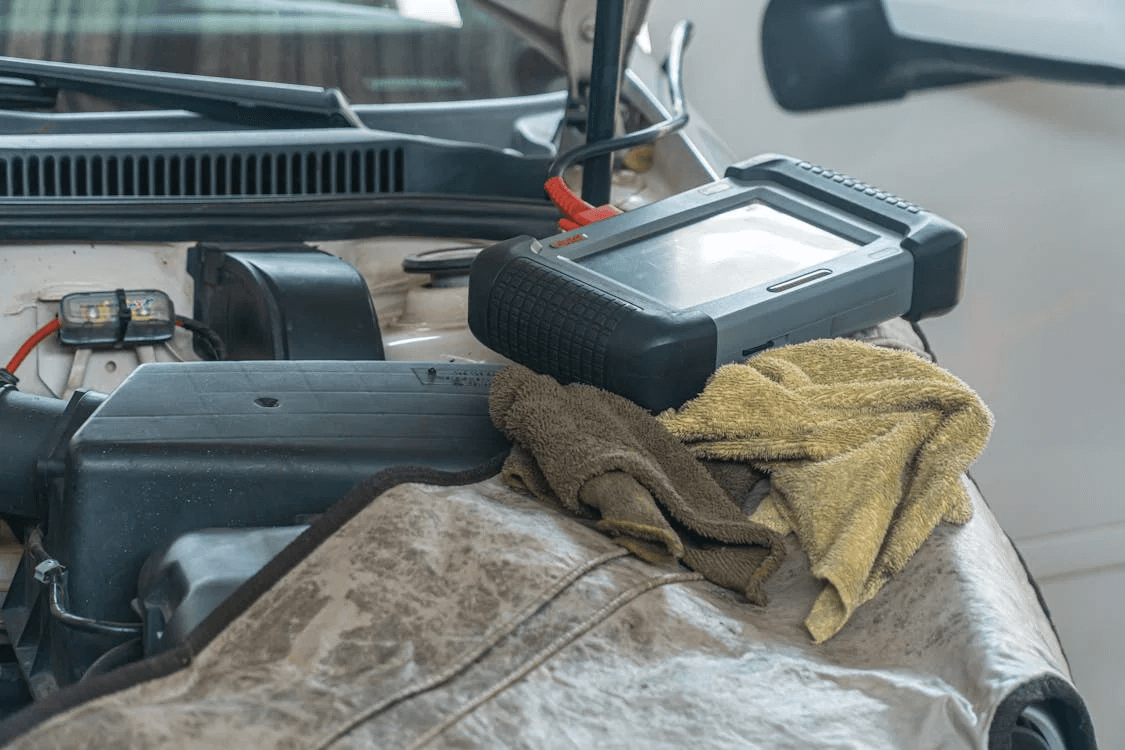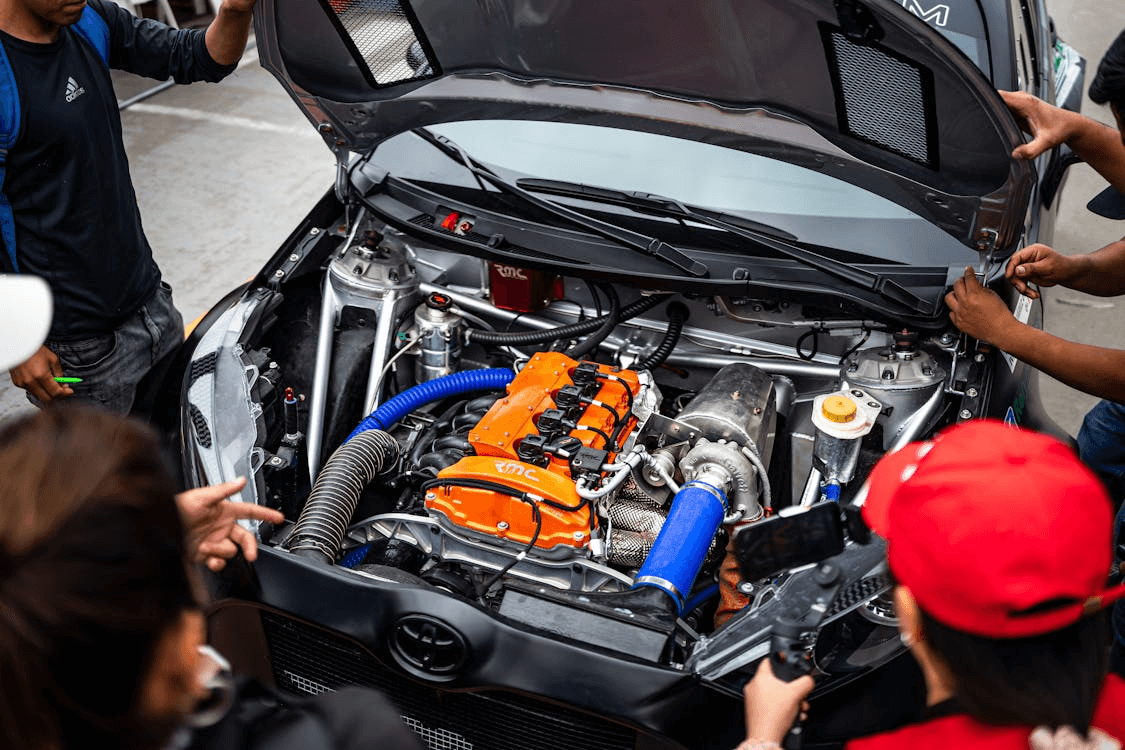Disclosure: we may get a commission from qualifying purchases made through affiliate links in this post but at no additional cost to you.
If you’ve ever had your check engine light come on and used an OBD-II scanner to diagnose the issue, you may have encountered the dreaded OBD code 420, also known as P0420. This diagnostic trouble code (DTC) indicates that your vehicle’s catalytic converter isn’t working as efficiently as it should. Since the catalytic converter plays a crucial role in reducing harmful emissions, a P0420 code can signal a serious issue that needs to be addressed promptly. In this guide, we’ll explore everything you need to know about OBD code 420, including what it means, common symptoms, possible causes, diagnostic steps, effective repair solutions, and preventive measures.

What Does OBD Code P0420 Mean?
The OBD code P0420, commonly referred to as OBD code 420, signifies a malfunction in the vehicle’s emission control system, specifically indicating that the catalytic converter’s efficiency is below the required threshold. This code is detected by the vehicle’s Powertrain Control Module (PCM) when it observes that the catalytic converter is not effectively reducing harmful emissions.
Understanding the Catalytic Converter’s Role
The catalytic converter is a vital component in the exhaust system, designed to convert harmful pollutants produced during combustion into less harmful emissions before they exit the tailpipe. It primarily transforms:
- Carbon monoxide (CO) into carbon dioxide (CO₂)
- Hydrocarbons (HC) into carbon dioxide (CO₂) and water (H₂O)
- Nitrogen oxides (NOx) into nitrogen (N₂) and oxygen (O₂)
To monitor the efficiency of the catalytic converter, vehicles are equipped with oxygen sensors placed before (upstream) and after (downstream) the converter. These sensors measure the oxygen levels in the exhaust gases. Under normal operating conditions, the upstream sensor’s readings fluctuate, while the downstream sensor’s readings remain relatively steady, indicating that the converter is effectively processing the exhaust gases. However, if the downstream sensor’s readings start to mirror those of the upstream sensor, it suggests that the catalytic converter is not functioning efficiently, triggering the P0420 code.
Implications of the P0420 Code
When the P0420 code is activated, it doesn’t always result in immediate drivability issues. However, it does indicate that the vehicle’s emissions are higher than acceptable levels, which can lead to:
- Failed emissions tests
- Reduced fuel efficiency
- Potential damage to other engine components
It’s essential to address this code promptly to ensure the vehicle remains environmentally compliant and operates efficiently.
Common Causes of the P0420 Code
Several factors can lead to the activation of the P0420 code:
- Degraded or failing catalytic converter
- Faulty oxygen sensors
- Exhaust leaks
- Engine misfires or incorrect air-fuel mixture
- Use of leaded gasoline or fuel additives that damage the converter
Proper diagnosis is crucial to determine the exact cause and implement the appropriate repair.
Common Symptoms of a P0420 Code
When your vehicle’s onboard diagnostics system detects OBD code 420, it signifies that the catalytic converter’s efficiency has fallen below the required threshold. While some drivers might not notice immediate changes in vehicle performance, several symptoms can indicate the presence of this code:
1. Illuminated Check Engine Light
The most immediate and common sign is the activation of the Check Engine Light. This warning light serves as an alert that the vehicle’s computer has identified an issue, specifically related to the emissions system’s efficiency.
2. Reduced Engine Performance
Drivers may experience a noticeable decline in engine power, especially during acceleration or while climbing hills. This reduction in performance is due to the catalytic converter’s diminished ability to process exhaust gases efficiently, leading to increased backpressure and restricted exhaust flow.
3. Decreased Fuel Efficiency
A failing catalytic converter can disrupt the optimal air-fuel mixture, causing the engine to consume more fuel than usual. As a result, you might observe a drop in miles per gallon (MPG), leading to more frequent visits to the gas station.
4. Unusual Exhaust Odors
A sulfuric or “rotten egg” smell emanating from the exhaust is a telltale sign of a malfunctioning catalytic converter. This odor results from the converter’s inability to adequately process hydrogen sulfide in the exhaust into odorless sulfur dioxide.
5. Rattling Noises from the Exhaust
If the internal components of the catalytic converter become damaged or break apart, they can produce a distinct rattling noise, especially during startup or acceleration. This sound indicates that the converter’s internal substrate may have disintegrated.
6. Failed Emissions Test
Since the catalytic converter plays a crucial role in reducing harmful emissions, its inefficiency can lead to elevated emission levels. Consequently, vehicles with an active OBD code 420 are likely to fail state or local emissions inspections.
7. Engine Misfires or Hesitation
In some cases, a compromised catalytic converter can lead to engine misfires or hesitation during acceleration. This occurs when unprocessed exhaust gases affect engine timing and combustion efficiency.
Recognizing these symptoms early can prevent further damage to your vehicle’s engine and exhaust system. If you notice any of these signs, it’s advisable to consult with a qualified mechanic to diagnose and address the issue promptly.

Potential Causes of the P0420 Code
The OBD code 420, also known as P0420, indicates that the catalytic converter’s efficiency is below the required threshold. While a failing catalytic converter is a common culprit, several other factors can trigger this code. Understanding these potential causes is crucial for accurate diagnosis and effective repair.
1. Faulty Catalytic Converter
The catalytic converter’s primary function is to reduce harmful emissions by converting exhaust gases into less harmful substances. Over time, it can become clogged, contaminated, or physically damaged, leading to decreased efficiency. Common reasons for catalytic converter failure include:
- Contamination: Exposure to substances like antifreeze or oil can coat the catalyst surfaces, reducing their effectiveness.
- Overheating: Excessive temperatures, often due to unburned fuel entering the exhaust system, can melt the converter’s internal components.
- Physical Damage: Impacts from road debris or improper handling during repairs can damage the converter.
It’s essential to address underlying issues that may have led to the converter’s failure to prevent recurrence.
2. Malfunctioning Oxygen Sensors
Oxygen sensors monitor the levels of oxygen in the exhaust gases before and after they pass through the catalytic converter. If these sensors are faulty or provide inaccurate readings, the engine control unit (ECU) may incorrectly interpret the converter’s efficiency, triggering the P0420 code. Common issues include:
- Sensor Aging: Over time, sensors can become less responsive or accurate.
- Contamination: Exposure to substances like silicone or lead can impair sensor function.
- Wiring Issues: Damaged or corroded wiring can disrupt sensor signals.
Regular inspection and timely replacement of oxygen sensors can help maintain accurate emissions monitoring.
3. Exhaust System Leaks
Leaks in the exhaust system, especially upstream of the catalytic converter, can introduce additional oxygen into the exhaust stream. This can skew oxygen sensor readings, leading the ECU to believe the converter is underperforming. Common causes of exhaust leaks include:
- Cracked Exhaust Manifold: Thermal stress can cause the manifold to crack over time.
- Loose or Damaged Gaskets: Gaskets can deteriorate, leading to leaks at connection points.
- Corroded Pipes: Rust and corrosion can create holes in the exhaust pipes.
Addressing exhaust leaks promptly ensures accurate sensor readings and optimal converter performance.
4. Engine Misfires
Misfires occur when the air-fuel mixture in a cylinder doesn’t ignite properly. Unburned fuel can then enter the exhaust system, leading to elevated temperatures and potential damage to the catalytic converter. Causes of misfires include:
- Faulty Spark Plugs or Ignition Coils: These components are essential for proper combustion.
- Fuel Delivery Issues: Clogged fuel injectors or a failing fuel pump can disrupt the air-fuel mixture.
- Vacuum Leaks: Unmetered air entering the engine can lead to lean conditions and misfires.
Regular engine maintenance can help prevent misfires and protect the catalytic converter.
5. Incorrect Air-Fuel Mixture
The optimal air-fuel ratio is crucial for efficient combustion and emissions control. Deviations from this ratio can result in incomplete combustion, leading to increased emissions and potential converter damage. Factors influencing the air-fuel mixture include:
- Mass Air Flow (MAF) Sensor Issues: A faulty MAF sensor can send incorrect airflow data to the ECU.
- Fuel Pressure Problems: A failing fuel pressure regulator can disrupt fuel delivery.
- Vacuum Leaks: As previously mentioned, they can introduce unmetered air into the engine.
Ensuring all components influencing the air-fuel mixture are functioning correctly is vital for emissions control.
6. Use of Leaded Fuel
While leaded gasoline is largely phased out, its use can severely damage the catalytic converter. Lead compounds coat the catalyst surfaces, rendering them ineffective. It’s essential to use only unleaded fuel in vehicles equipped with catalytic converters.
7. ECU Software Issues
In some cases, the engine control unit’s software may misinterpret sensor data, leading to false P0420 codes. Manufacturers may release software updates or technical service bulletins (TSBs) to address such issues. If all hardware components are functioning correctly, checking for ECU updates may be beneficial.
Understanding the various potential causes of the P0420 code is crucial for accurate diagnosis and effective repair. Addressing the root cause, rather than just the symptoms, ensures long-term vehicle performance and compliance with emissions standards.

Diagnosing the P0420 Code
Diagnosing OBD code P0420, which indicates “Catalyst System Efficiency Below Threshold (Bank 1),” requires a systematic approach to pinpoint the exact cause. While the code often suggests a failing catalytic converter, other components can also trigger this warning. Here’s a step-by-step guide to effectively diagnose the issue:
Step 1: Confirm the Code and Check for Additional DTCs
Use a reliable OBD-II scanner to confirm the presence of the P0420 code. It’s crucial to check for any additional diagnostic trouble codes (DTCs) that might be present, as they can provide insights into related issues affecting the catalytic converter’s performance. For instance, codes related to oxygen sensors, misfires, or fuel system anomalies can influence the converter’s efficiency.
Step 2: Inspect the Exhaust System for Leaks
Exhaust leaks, especially upstream of the catalytic converter, can introduce excess oxygen into the exhaust stream, leading to erroneous readings by the oxygen sensors. Carefully inspect the exhaust manifold, gaskets, and pipes for any signs of leaks, cracks, or damage. Even minor leaks can disrupt the air-fuel ratio, affecting the converter’s efficiency.
Step 3: Evaluate Oxygen Sensor Performance
The vehicle’s oxygen sensors play a pivotal role in monitoring the efficiency of the catalytic converter. The upstream (pre-catalytic) sensor measures the oxygen content before the exhaust gases enter the converter, while the downstream (post-catalytic) sensor measures it after. Under normal conditions, the upstream sensor’s readings fluctuate, reflecting changes in the exhaust’s oxygen content, whereas the downstream sensor’s readings should remain relatively stable if the converter is functioning correctly.
If both sensors display similar fluctuating patterns, it suggests that the converter isn’t effectively processing the exhaust gases. Utilize live data from the OBD-II scanner to compare the voltage readings of both sensors. Significant similarities in their readings can indicate a malfunctioning catalytic converter or faulty sensors.
Step 4: Conduct a Catalytic Converter Efficiency Test
To assess the converter’s efficiency, perform a temperature test using an infrared thermometer. Measure the temperature at the inlet and outlet of the catalytic converter. A properly functioning converter will exhibit a higher temperature at the outlet compared to the inlet, typically by about 100°F (55°C) or more. A negligible temperature difference suggests that the converter isn’t effectively processing the exhaust gases.
Additionally, a backpressure test can determine if the converter is clogged. Excessive backpressure indicates a blockage, which can impede exhaust flow and reduce engine performance.
Step 5: Check for Engine Performance Issues
Engine-related problems, such as misfires, incorrect air-fuel mixtures, or faulty ignition components, can lead to unburned fuel entering the exhaust system. This unburned fuel can overheat and damage the catalytic converter. Inspect spark plugs, ignition coils, and fuel injectors for proper operation. Addressing these issues is crucial before replacing the converter to prevent recurring problems.
Step 6: Examine Fuel and Emission Control Systems
Issues within the fuel and emission control systems can also trigger the P0420 code. Inspect components such as the fuel pressure regulator, mass airflow sensor (MAF), and engine coolant temperature sensor. Malfunctions in these systems can lead to incorrect fuel delivery or combustion temperatures, affecting the converter’s efficiency.
Step 7: Review Vehicle Software and Technical Service Bulletins (TSBs)
In some cases, the vehicle’s engine control module (ECM) may require a software update to accurately monitor the catalytic converter’s performance. Manufacturers occasionally release TSBs addressing known issues related to the P0420 code. Consult the manufacturer’s database or a dealership to check for any applicable updates or recalls.
By meticulously following these diagnostic steps, you can accurately identify the root cause of the P0420 code. Addressing the underlying issue ensures optimal vehicle performance, compliance with emission standards, and prevents unnecessary replacement of functional components.
Effective Solutions for Resolving P0420
Addressing the OBD code 420 (P0420) requires a systematic approach, as the underlying causes can vary. Below are the most effective solutions, ranging from simple fixes to more involved repairs:
1. Replace the Catalytic Converter
If diagnostics confirm that the catalytic converter is failing or has lost efficiency, replacement is often the most definitive solution. It’s crucial to:
- Ensure the replacement converter meets OEM specifications.
- Address any underlying issues (e.g., misfires, oil leaks) that could damage the new converter.
- Consider using high-quality aftermarket converters if OEM parts are cost-prohibitive.
2. Replace Faulty Oxygen Sensors
Oxygen sensors monitor the efficiency of the catalytic converter. A malfunctioning sensor can trigger a false P0420 code. Steps include:
- Using an OBD-II scanner to check sensor readings.
- Replacing sensors that show erratic or identical readings upstream and downstream.
- Ensuring proper installation and connector integrity.
3. Repair Exhaust Leaks
Exhaust leaks, especially near the oxygen sensors or catalytic converter, can lead to incorrect readings and trigger the P0420 code. To address this:
- Inspect the exhaust system for cracks, holes, or loose connections.
- Repair or replace damaged sections of the exhaust.
- Ensure all gaskets and seals are intact and functioning properly.
4. Use Catalytic Converter Cleaners
In cases where the catalytic converter is not severely damaged, using a cleaner can help restore its efficiency:
- A Catalytic Converter Cleaner can be added to the fuel tank to clean the exhaust system.
- Follow the manufacturer’s instructions carefully for optimal results.
- Note that while some users report success, results can vary based on the severity of the issue.
5. Perform an Engine Tune-Up
Underlying engine issues can affect the performance of the catalytic converter. A comprehensive tune-up can include:
- Replacing spark plugs and ignition coils.
- Cleaning or replacing the mass airflow sensor.
- Ensuring the fuel injectors are clean and functioning correctly.
- Checking for and addressing any engine misfires.
6. Update the Engine Control Unit (ECU) Software
In some cases, manufacturers release software updates to address false P0420 codes:
- Consult with a dealership or authorized service center to check for available ECU updates.
- Updating the software can recalibrate the oxygen sensor thresholds and improve diagnostics.
7. Install Oxygen Sensor Spacers (Non-Foulers)
As a temporary workaround, some have used oxygen sensor spacers to prevent the P0420 code from triggering:
- These spacers move the sensor slightly out of the direct exhaust flow, potentially reducing false readings.
- It’s essential to note that this is not a long-term solution and may not be compliant with emissions regulations.
By systematically addressing these areas, you can effectively resolve the P0420 code and restore your vehicle’s performance. If you’re uncertain about any steps, it’s advisable to consult with a certified mechanic to ensure accurate diagnostics and repairs.
Preventive Measures to Avoid P0420
Preventing the OBD code P0420, which indicates a “Catalyst System Efficiency Below Threshold,” involves proactive maintenance and mindful driving habits. By implementing the following strategies, you can enhance your vehicle’s performance, ensure compliance with emission standards, and avoid costly repairs.
1. Adhere to Regular Maintenance Schedules
- Timely Oil Changes: Regular oil changes prevent engine oil from contaminating the catalytic converter, which can lead to decreased efficiency.
- Replace Spark Plugs and Air Filters: Worn-out spark plugs can cause misfires, leading to unburned fuel entering the exhaust system. Similarly, dirty air filters can disrupt the air-fuel mixture, affecting combustion and increasing emissions.
- Use High-Quality Fuel: Opt for top-tier gasoline to minimize the buildup of deposits in the engine and exhaust system, thereby protecting the catalytic converter.
2. Monitor and Address Engine Performance Issues Promptly
- Check Engine Light: Never ignore the check engine light. Even if the vehicle seems to run smoothly, underlying issues can escalate, leading to catalytic converter damage.
- Engine Misfires: Address misfires immediately, as they can cause raw fuel to enter the exhaust system, overheating and damaging the catalytic converter.
- Fuel System Maintenance: Ensure that fuel injectors and the fuel pressure regulator are functioning correctly to maintain the optimal air-fuel ratio.
3. Inspect the Exhaust System Regularly
- Check for Leaks: Exhaust leaks before the catalytic converter can introduce extra oxygen into the system, causing incorrect readings from the oxygen sensors and triggering the P0420 code.
- Secure Connections: Ensure all exhaust components are securely connected and free from rust or damage that could lead to leaks.
4. Maintain Oxygen Sensors
- Regular Inspection: Oxygen sensors play a crucial role in monitoring the efficiency of the catalytic converter. Faulty sensors can provide inaccurate data, leading to erroneous P0420 codes.
- Timely Replacement: Replace oxygen sensors as recommended by the manufacturer, typically every 60,000 to 100,000 miles, to ensure accurate readings.
5. Avoid Short Trips
- Allow Engine to Reach Operating Temperature: Short trips prevent the engine and catalytic converter from reaching optimal operating temperatures, leading to incomplete combustion and increased emissions.
- Combine Errands: Plan trips to allow the engine to run longer, ensuring that the catalytic converter operates efficiently and burns off accumulated deposits.
6. Use Fuel Additives Judiciously
- Catalytic Converter Cleaners: Periodically using fuel additives designed to clean the catalytic converter can help maintain its efficiency.
- Follow Manufacturer Guidelines: Always adhere to the manufacturer’s instructions when using fuel additives to avoid potential damage to the engine or exhaust system.
7. Ensure Proper Engine Tuning
- Regular Tune-Ups: Keeping the engine properly tuned ensures optimal combustion, reducing the risk of unburned fuel entering the exhaust system.
- Monitor Engine Sensors: Ensure that sensors such as the mass airflow sensor and throttle position sensor are functioning correctly, as they influence the air-fuel mixture and overall engine performance.
8. Address Oil Consumption Issues
- Monitor Oil Levels: Excessive oil consumption can lead to oil entering the combustion chamber and subsequently the exhaust system, contaminating the catalytic converter.
- Repair Oil Leaks: Fix any oil leaks promptly to prevent oil from reaching the catalytic converter and causing damage.
9. Avoid Aftermarket Modifications That Affect Emissions
- Exhaust System Modifications: Altering the exhaust system can affect the performance of the catalytic converter and oxygen sensors, potentially leading to P0420 codes.
- Use OEM Parts: When replacing components, opt for Original Equipment Manufacturer (OEM) parts to ensure compatibility and maintain emission standards.
10. Stay Informed and Educated
- Understand Your Vehicle: Familiarize yourself with your vehicle’s maintenance schedule and emission control system to proactively address potential issues.
- Consult Professionals: When in doubt, seek advice from certified mechanics to ensure that your vehicle remains in compliance with emission standards and operates efficiently.
By implementing these preventive measures, you can significantly reduce the likelihood of encountering the OBD code 420 and ensure that your vehicle’s emission control system functions optimally. Regular maintenance, attentive driving habits, and prompt attention to engine performance issues are key to maintaining the health of your catalytic converter and overall vehicle performance.

When to Seek Professional Assistance
While some vehicle owners may attempt to diagnose and address the OBD code 420 (P0420) on their own, certain situations necessitate the expertise of a professional mechanic. Recognizing when to seek professional assistance can prevent further damage, ensure accurate diagnostics, and save time and resources in the long run.
1. Persistent Check Engine Light After Repairs
If you’ve replaced components such as oxygen sensors or addressed potential exhaust leaks, yet the check engine light remains illuminated with the P0420 code, it’s a clear indication that the issue persists. A professional mechanic can perform advanced diagnostics to uncover underlying problems that may not be apparent through basic troubleshooting.
2. Multiple or Conflicting Diagnostic Trouble Codes
The presence of additional codes alongside P0420, such as P0300 (random/multiple cylinder misfire) or P0171 (system too lean), can complicate the diagnostic process. These codes may indicate issues that contribute to or result from the catalyst system’s inefficiency. Professionals have the tools and experience to interpret these codes accurately and determine their interrelations.
3. Failed Emissions Test
A failed emissions test due to a P0420 code requires prompt attention from a certified technician. They can conduct a thorough inspection to identify the root cause, whether it’s a failing catalytic converter, faulty oxygen sensors, or other related issues, and perform necessary repairs to ensure compliance with emission standards.
4. Unusual Vehicle Performance Issues
Experiencing symptoms such as reduced engine performance, poor fuel economy, or a noticeable sulfuric (rotten egg) smell from the exhaust suggests that the catalytic converter may not be functioning correctly. These signs warrant a professional evaluation to prevent potential damage to the engine or exhaust system.
5. Lack of Diagnostic Tools and Expertise
Diagnosing and repairing issues related to the P0420 code often require specialized equipment, such as advanced OBD-II scanners capable of reading live data and performing specific tests. If you lack access to these tools or the technical knowledge to interpret the results, consulting a professional is advisable.
6. Underlying Engine or Fuel System Problems
Sometimes, the P0420 code is a symptom of deeper issues within the engine or fuel system, such as fuel injector problems, ignition system malfunctions, or air-fuel mixture imbalances. Professionals can conduct comprehensive diagnostics to uncover and address these underlying problems, ensuring a holistic repair approach.
7. Repeated Occurrence of the P0420 Code
If the P0420 code reappears shortly after being cleared, it indicates that the root cause has not been resolved. Repeated occurrences necessitate a more in-depth investigation by a professional to identify persistent or recurring issues that may not be evident through standard diagnostics.
8. Preparation for Long-Distance Travel
Before embarking on extended trips, it’s prudent to address any existing diagnostic trouble codes, including P0420. A professional inspection can ensure that your vehicle is in optimal condition, reducing the risk of breakdowns or performance issues during your journey.
In summary, while some basic troubleshooting steps can be performed independently, certain scenarios require the expertise of a professional mechanic to accurately diagnose and resolve issues associated with the OBD code 420. Timely professional intervention not only ensures your vehicle’s optimal performance and compliance with emission standards but also safeguards against potential long-term damage and costly repairs.
Conclusion
Dealing with OBD code 420, also known as P0420, may initially seem overwhelming, especially when the check engine light appears without any obvious signs of a problem. However, understanding what this code represents—namely a catalytic converter efficiency issue—and knowing how to identify its symptoms and causes puts you in control of the situation.
From diagnosing faulty oxygen sensors to recognizing exhaust leaks or engine misfires, there are actionable steps you can take to pinpoint the root cause. Timely repairs not only restore your vehicle’s performance but also help you pass emissions tests and avoid costly fines or replacements. More importantly, addressing OBD code 420 promptly protects the environment by ensuring your vehicle continues to reduce harmful emissions effectively. By staying proactive with regular maintenance and seeking professional help when necessary, you can minimize the likelihood of this code recurring and keep your engine—and the planet—running clean.
